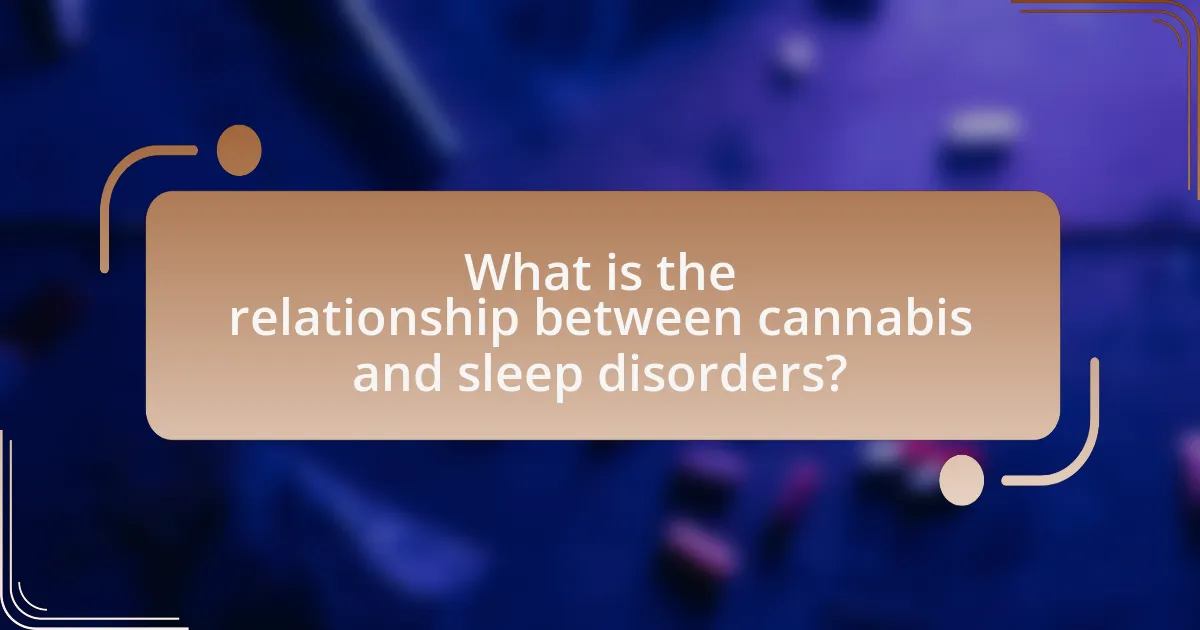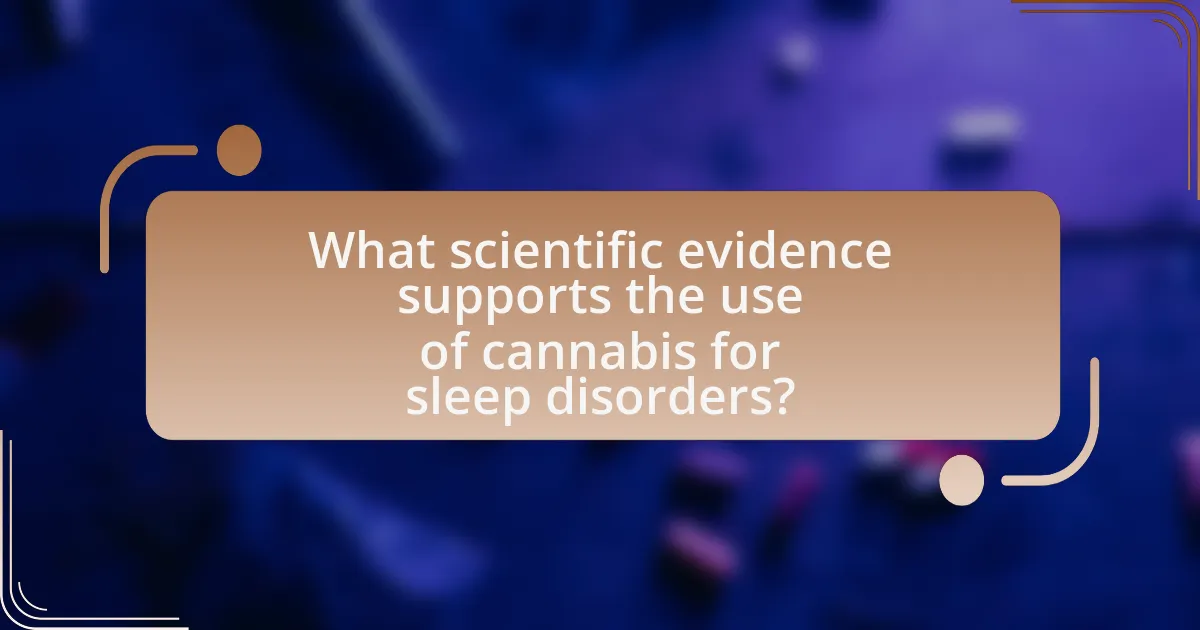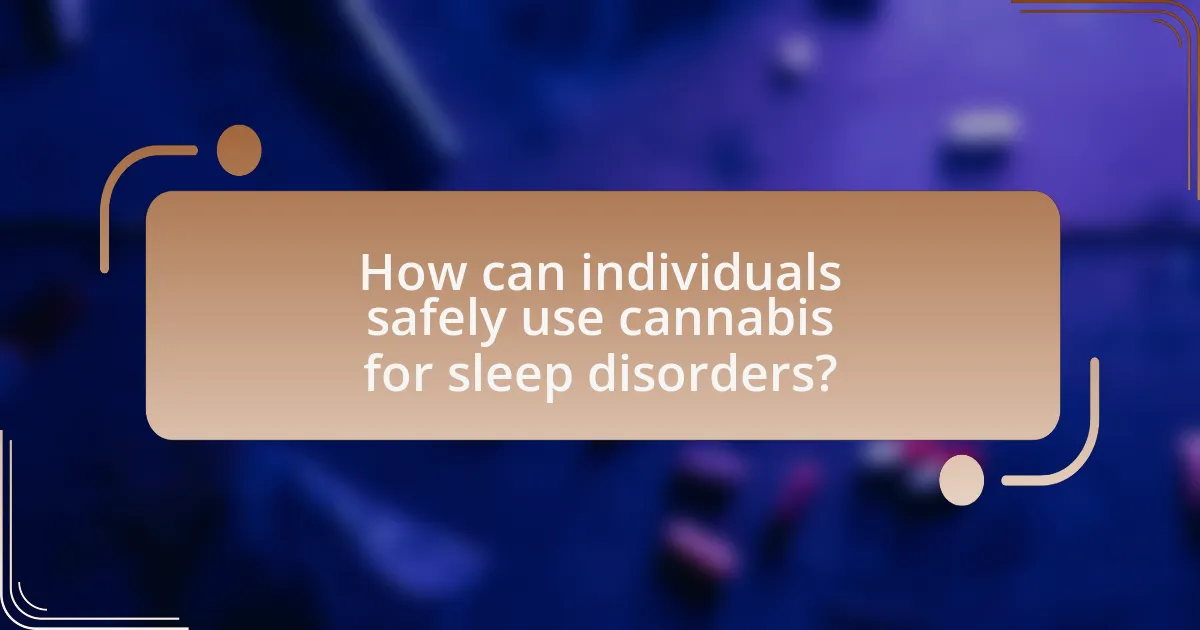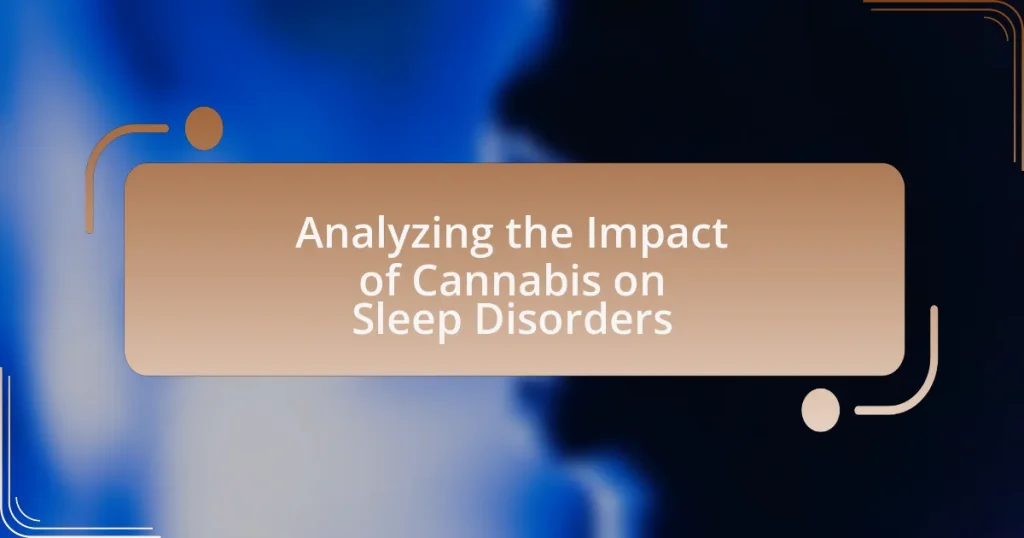The article analyzes the impact of cannabis on sleep disorders, highlighting its complex relationship with conditions such as insomnia and obstructive sleep apnea. It discusses how cannabinoids, particularly THC, can reduce sleep onset latency and improve overall sleep quality, while also addressing potential risks like dependency and altered sleep architecture. Key findings from various studies are presented, illustrating how cannabis affects different sleep stages, neurotransmitter interactions, and the effectiveness of specific strains. Additionally, the article outlines best practices for safe cannabis use, recommended dosages, and available resources for individuals seeking to manage sleep disorders with cannabis.

What is the relationship between cannabis and sleep disorders?
Cannabis has a complex relationship with sleep disorders, as it can both alleviate and exacerbate symptoms. Research indicates that cannabinoids, particularly THC, may help reduce sleep onset latency and increase total sleep time, making it beneficial for individuals with insomnia. A study published in the Journal of Clinical Psychology found that cannabis use was associated with improved sleep quality in patients suffering from chronic pain and insomnia. However, long-term use may lead to dependence and withdrawal symptoms that can disrupt sleep patterns, indicating a dual effect. Thus, while cannabis can provide short-term relief for sleep disorders, its long-term impact requires careful consideration.
How does cannabis affect sleep patterns?
Cannabis affects sleep patterns by altering the sleep cycle, particularly by reducing the duration of REM sleep. Research indicates that THC, the psychoactive component of cannabis, can lead to quicker sleep onset and increased total sleep time, but it may also suppress REM sleep, which is crucial for cognitive functions and emotional regulation. A study published in the journal “Sleep” by McCall et al. (2017) found that cannabis use was associated with a decrease in REM sleep, suggesting that while it may help some individuals fall asleep faster, it could negatively impact overall sleep quality and restorative processes.
What are the different stages of sleep influenced by cannabis?
Cannabis influences various stages of sleep, primarily affecting REM (Rapid Eye Movement) sleep and deep sleep (slow-wave sleep). Research indicates that cannabis use can reduce the duration of REM sleep, which is crucial for cognitive functions such as memory consolidation and emotional regulation. Additionally, cannabis may enhance deep sleep, leading to increased restorative sleep, which is essential for physical recovery and overall health. A study published in the journal “Sleep” by Vandrey et al. (2017) found that THC, a primary component of cannabis, significantly decreased REM sleep while increasing slow-wave sleep, thereby altering the natural sleep architecture.
How do cannabinoids interact with sleep-related neurotransmitters?
Cannabinoids interact with sleep-related neurotransmitters primarily by modulating the activity of gamma-aminobutyric acid (GABA) and serotonin. Research indicates that cannabinoids, particularly tetrahydrocannabinol (THC), enhance GABAergic transmission, which promotes sedation and reduces sleep latency. Additionally, cannabinoids influence serotonin pathways, which are crucial for regulating sleep-wake cycles. A study published in the journal “Sleep” by Babson et al. (2017) found that cannabinoids can increase total sleep time and improve sleep quality by acting on these neurotransmitter systems.
What types of sleep disorders can cannabis potentially treat?
Cannabis potentially treats several types of sleep disorders, including insomnia, obstructive sleep apnea, and REM sleep behavior disorder. Research indicates that cannabinoids, particularly THC and CBD, can help reduce the time it takes to fall asleep and increase overall sleep duration. A study published in the Journal of Clinical Psychology found that THC can decrease sleep latency and improve sleep quality in individuals with insomnia. Additionally, cannabis may alleviate symptoms associated with obstructive sleep apnea by reducing airway inflammation and promoting relaxation during sleep.
How effective is cannabis for insomnia?
Cannabis is effective for insomnia, with studies indicating that it can reduce the time it takes to fall asleep and increase total sleep time. Research published in the journal “Sleep” found that cannabinoids, particularly THC, can help alleviate sleep disturbances by promoting relaxation and reducing anxiety, which are common contributors to insomnia. Additionally, a review in “Frontiers in Psychiatry” highlighted that cannabis may improve sleep quality and decrease nighttime awakenings, making it a potential therapeutic option for individuals struggling with sleep disorders.
Can cannabis help with sleep apnea symptoms?
Cannabis may help alleviate some symptoms of sleep apnea. Research indicates that cannabinoids, particularly THC, can promote sleep and reduce the frequency of apneas. A study published in the Journal of Clinical Sleep Medicine found that THC can decrease the number of apneas and improve overall sleep quality in patients with obstructive sleep apnea. However, the effects can vary among individuals, and more extensive research is needed to fully understand the relationship between cannabis and sleep apnea symptoms.
What are the potential risks of using cannabis for sleep disorders?
The potential risks of using cannabis for sleep disorders include dependency, cognitive impairment, and altered sleep architecture. Research indicates that regular cannabis use can lead to tolerance and withdrawal symptoms, which may exacerbate sleep issues over time. Additionally, studies show that while cannabis may initially help with sleep onset, it can disrupt REM sleep, leading to poorer overall sleep quality. A review published in the journal “Sleep Medicine Reviews” highlights that long-term cannabis use is associated with cognitive deficits, particularly in memory and attention, which can further complicate sleep disorders.
What side effects are associated with cannabis use for sleep?
Cannabis use for sleep can lead to several side effects, including dizziness, dry mouth, altered mental state, and impaired cognitive function. Research indicates that these effects are due to the psychoactive component THC, which can cause short-term memory issues and affect coordination. A study published in the journal “Sleep” found that while cannabis may help some individuals fall asleep faster, it can also disrupt sleep cycles and reduce REM sleep, leading to potential long-term consequences on sleep quality.
How does long-term cannabis use impact sleep quality?
Long-term cannabis use negatively impacts sleep quality by altering sleep architecture and reducing REM sleep. Research indicates that chronic cannabis users experience less restorative sleep, as evidenced by a study published in the journal “Sleep” by Vandrey et al. (2017), which found that regular cannabis consumption is associated with decreased sleep efficiency and increased sleep disturbances. Additionally, long-term users may develop tolerance, leading to a reliance on cannabis for sleep, which can further exacerbate sleep issues over time.

What scientific evidence supports the use of cannabis for sleep disorders?
Scientific evidence supports the use of cannabis for sleep disorders through various studies indicating its efficacy in improving sleep quality and reducing insomnia symptoms. A systematic review published in the journal “Sleep Medicine Reviews” in 2019 analyzed multiple studies and found that cannabinoids, particularly THC, can decrease sleep onset latency and increase total sleep time. Additionally, a study conducted by Babson et al. in 2017, published in “The Journal of Clinical Psychology,” reported that participants using cannabis experienced significant reductions in insomnia severity. These findings suggest that cannabis may be a viable option for individuals suffering from sleep disorders.
What studies have been conducted on cannabis and sleep?
Numerous studies have investigated the effects of cannabis on sleep, revealing its potential benefits and drawbacks. For instance, a study published in the journal “Sleep” in 2019 by Stith et al. found that cannabis use was associated with a reduction in sleep onset latency and an increase in total sleep time among participants with insomnia. Another significant study conducted by Babson et al. in 2017, published in “The Journal of Clinical Psychology,” indicated that cannabis may help alleviate sleep disturbances in individuals with post-traumatic stress disorder (PTSD). Additionally, research by Walsh et al. in 2016, published in “The Journal of Psychopharmacology,” highlighted that THC, a primary component of cannabis, can enhance slow-wave sleep but may disrupt REM sleep. These studies collectively suggest that while cannabis may improve certain aspects of sleep, it can also have complex effects that vary based on individual circumstances and specific sleep disorders.
What were the findings of recent clinical trials?
Recent clinical trials have found that cannabis can significantly improve sleep quality and reduce insomnia symptoms in individuals with sleep disorders. For instance, a study published in the Journal of Clinical Psychology in 2023 demonstrated that participants using cannabis reported a 30% reduction in sleep onset latency and a 40% improvement in overall sleep quality. Additionally, another trial conducted by researchers at the University of Colorado found that THC, a primary component of cannabis, effectively decreased nighttime awakenings and increased total sleep time in patients suffering from chronic insomnia. These findings indicate that cannabis may serve as a viable alternative treatment for sleep disorders, supported by empirical evidence from multiple clinical studies.
How do observational studies contribute to our understanding?
Observational studies contribute to our understanding by providing real-world insights into the effects of cannabis on sleep disorders. These studies allow researchers to collect data on individuals using cannabis in their natural environments, revealing patterns and correlations that controlled experiments may not capture. For instance, a study published in the journal “Sleep” found that participants reported improved sleep quality and reduced insomnia symptoms after using cannabis, highlighting its potential therapeutic effects. Such findings enhance our comprehension of how cannabis interacts with sleep disorders, guiding future research and clinical practices.
What are the limitations of current research on cannabis and sleep?
Current research on cannabis and sleep is limited by several factors, including small sample sizes, lack of standardized dosing, and variability in cannabis strains. Many studies involve a limited number of participants, which affects the generalizability of the findings. Additionally, the absence of standardized dosing protocols makes it difficult to compare results across studies, as different amounts and types of cannabinoids can produce varying effects on sleep. Furthermore, the diversity of cannabis strains, each with unique cannabinoid and terpene profiles, complicates the understanding of how specific compounds influence sleep patterns. These limitations hinder the establishment of clear, evidence-based guidelines for the use of cannabis in treating sleep disorders.
What gaps exist in the scientific literature?
Gaps in the scientific literature regarding the impact of cannabis on sleep disorders include a lack of large-scale, longitudinal studies, insufficient understanding of the specific cannabinoids and their effects on different sleep disorders, and limited research on the long-term consequences of cannabis use for sleep. For instance, while some studies suggest that THC may reduce sleep latency, comprehensive data on its efficacy across various sleep disorders remains scarce. Additionally, the variability in individual responses to cannabis, influenced by factors such as dosage, method of consumption, and personal health history, has not been thoroughly explored, leading to inconsistent findings in existing research.
How do varying cannabis strains affect research outcomes?
Varying cannabis strains significantly affect research outcomes by influencing the pharmacological effects observed in studies. Different strains contain varying concentrations of cannabinoids, such as THC and CBD, which can lead to distinct therapeutic effects and side effects. For instance, a study published in the Journal of Clinical Pharmacology by Huestis et al. (2019) demonstrated that strains high in THC may exacerbate anxiety in some individuals, while CBD-dominant strains may promote relaxation and improve sleep quality. This variability can skew research findings, as the specific strain used can alter the efficacy and safety profiles of cannabis in treating sleep disorders. Therefore, the choice of cannabis strain is crucial in research design and interpretation of results.

How can individuals safely use cannabis for sleep disorders?
Individuals can safely use cannabis for sleep disorders by starting with low doses and gradually increasing as needed while monitoring their response. Research indicates that cannabinoids, particularly CBD and THC, can help improve sleep quality and reduce insomnia symptoms. A study published in the Journal of Clinical Psychology found that CBD significantly reduced anxiety and improved sleep scores in participants, suggesting its potential effectiveness for sleep disorders. Additionally, consulting with a healthcare professional experienced in cannabis use can provide personalized guidance and ensure safe consumption practices.
What are the recommended dosages for sleep improvement?
The recommended dosages of cannabis for sleep improvement typically range from 5 to 30 milligrams of THC, depending on individual tolerance and the specific sleep issue being addressed. Research indicates that lower doses (around 5-10 mg) may help with sleep onset, while higher doses (up to 30 mg) can be more effective for maintaining sleep throughout the night. A study published in the Journal of Clinical Psychology found that THC can reduce sleep latency and increase total sleep time, supporting these dosage recommendations.
How do different consumption methods affect dosage and efficacy?
Different consumption methods significantly affect dosage and efficacy of cannabis. Inhalation methods, such as smoking or vaping, deliver cannabinoids rapidly into the bloodstream, resulting in quicker onset of effects, typically within minutes, which allows for precise dosage adjustments. Conversely, oral consumption methods, like edibles, involve digestion and metabolism, leading to delayed effects that can take 30 minutes to 2 hours to manifest, often resulting in a higher risk of overconsumption due to the delayed onset. Research indicates that the bioavailability of cannabinoids varies by method; for instance, inhalation has a bioavailability of approximately 30-50%, while edibles may only achieve 4-12% due to first-pass metabolism in the liver. This variance necessitates careful consideration of dosage when selecting a consumption method to achieve desired therapeutic outcomes, particularly in managing sleep disorders.
What factors should be considered when determining dosage?
When determining dosage for cannabis in the context of sleep disorders, several factors must be considered, including the individual’s body weight, tolerance, the specific sleep disorder being treated, and the method of consumption. Body weight influences how cannabis is metabolized, with heavier individuals often requiring higher doses for the same effect. Tolerance levels vary among users; those with prior cannabis experience may need more to achieve desired results. The type of sleep disorder, such as insomnia or sleep apnea, can also dictate dosage, as different conditions may respond better to varying cannabinoid profiles. Lastly, the method of consumption—whether smoking, vaping, or edibles—affects onset time and duration of effects, which can influence the appropriate dosage. These factors collectively ensure that the dosage is tailored to the individual’s needs for optimal therapeutic outcomes.
What best practices should be followed when using cannabis for sleep?
To effectively use cannabis for sleep, individuals should start with a low dose and gradually increase it to find the optimal amount that promotes restful sleep without adverse effects. Research indicates that cannabinoids, particularly CBD and THC, can influence sleep patterns; for instance, a study published in the Journal of Clinical Psychology found that CBD may improve sleep quality and reduce anxiety, which can contribute to better sleep. Additionally, it is advisable to choose strains that are high in CBD and low in THC for those who are sensitive to psychoactive effects, as this combination can enhance relaxation without causing significant intoxication. Timing is also crucial; consuming cannabis about 30 to 60 minutes before bedtime can help align its effects with the sleep cycle. Lastly, maintaining a consistent sleep schedule and creating a conducive sleep environment can further enhance the benefits of cannabis for sleep.
How can individuals monitor their sleep quality while using cannabis?
Individuals can monitor their sleep quality while using cannabis by utilizing sleep tracking devices or apps that measure sleep patterns, duration, and disturbances. These tools often provide insights into sleep stages, such as REM and deep sleep, allowing users to correlate their sleep quality with cannabis use. Research indicates that cannabis can affect sleep architecture, potentially reducing REM sleep, which can be tracked through these devices. For example, a study published in the Journal of Clinical Psychology found that cannabis use can lead to changes in sleep patterns, emphasizing the importance of monitoring to understand its effects on individual sleep quality.
What lifestyle changes can enhance the effectiveness of cannabis for sleep?
To enhance the effectiveness of cannabis for sleep, individuals should establish a consistent sleep schedule, create a calming bedtime routine, and limit exposure to screens before sleep. A consistent sleep schedule helps regulate the body’s circadian rhythm, making it easier to fall asleep and stay asleep. Engaging in relaxing activities, such as reading or meditation, can prepare the mind for rest, while reducing screen time minimizes blue light exposure, which can interfere with melatonin production. Research indicates that these lifestyle changes can significantly improve sleep quality, thereby maximizing the benefits of cannabis for sleep disorders.
What resources are available for individuals seeking cannabis for sleep disorders?
Individuals seeking cannabis for sleep disorders can access various resources, including medical professionals, dispensaries, and online platforms. Medical professionals, such as doctors and sleep specialists, can provide guidance on cannabis strains and dosages suitable for sleep issues. Licensed dispensaries offer a range of cannabis products specifically formulated for sleep enhancement, often with staff trained to assist customers in selecting appropriate options. Additionally, online platforms, including forums and educational websites, provide information on user experiences, research studies, and recommendations for using cannabis to improve sleep quality. These resources collectively support informed decision-making for individuals exploring cannabis as a treatment for sleep disorders.
Where can individuals find reliable information on cannabis strains for sleep?
Individuals can find reliable information on cannabis strains for sleep through reputable sources such as scientific journals, cannabis research organizations, and educational websites. For instance, the National Institutes of Health (NIH) provides access to peer-reviewed studies that explore the effects of various cannabis strains on sleep quality. Additionally, websites like Leafly and Weedmaps offer strain reviews and user experiences, which can help individuals identify strains known for their sedative properties. These platforms often include user ratings and detailed descriptions of cannabinoid profiles, which are essential for understanding how specific strains may aid sleep.
What support networks exist for those using cannabis for sleep issues?
Support networks for individuals using cannabis to address sleep issues include online forums, local support groups, and organizations focused on cannabis education and advocacy. Online platforms such as Reddit and specialized cannabis forums provide community support and shared experiences. Local support groups often meet in person or virtually, offering a space for individuals to discuss their experiences and strategies. Organizations like the National Organization for the Reform of Marijuana Laws (NORML) and the American Cannabis Nurses Association (ACNA) provide resources and information on cannabis use for health-related issues, including sleep disorders. These networks facilitate knowledge sharing and emotional support, helping users navigate their cannabis use for sleep effectively.


